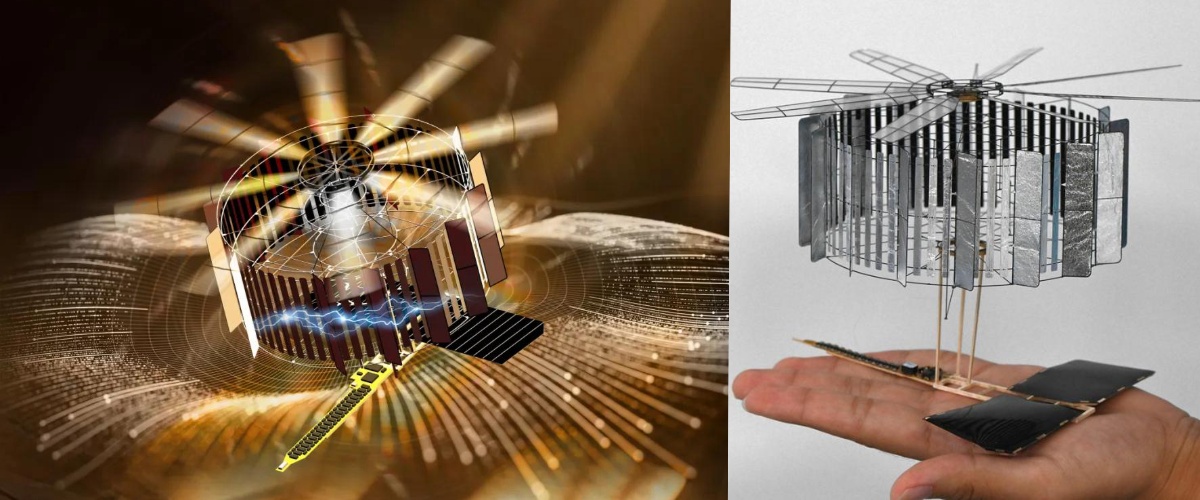This Might Be the Most Elegant Drone You’ve Ever Seen

The morning sun bathes Beijing in a golden glow, its rays streaming through an open window and dancing across the room. In this shaft of light, a small, palm-sized device quietly hums to life. Within seconds, it lifts off the ground, hovering steadily in mid-air. This isn’t just any drone – it’s a groundbreaking micro aerial vehicle (MAV) that’s making history as well as being the smallest and lightest drone ever.
 Researchers from Beijing’s Beihang University have developed a sunlight-powered MAV weighing just 4.21 grams.
Researchers from Beijing’s Beihang University have developed a sunlight-powered MAV weighing just 4.21 grams.
In a remarkable leap forward for ultra-light aircraft technology, researchers from Beijing’s Beihang University have developed a sunlight-powered MAV weighing just 4.21 grams – about as much as a sheet of A4 paper. This tiny marvel, known as CoulombFly, with its 20-centimeter wingspan, represents a dramatic downsizing from previous sun-powered flying machines, which were typically meter-sized and weighed kilograms.
 The structure of CoulombFly.
The structure of CoulombFly.
The key to this miniaturization lies in the vehicle’s innovative propulsion system. At its heart is an electrostatic motor, a departure from the electromagnetic motors traditionally used in drones. This electrostatic motor operates on entirely different principles, using high-voltage electric fields to drive its rotor blades.
This electrostatic motor consumes incredibly little power – just 137 milliwatts – while providing an impressive lift-to-power efficiency of 30.7 grams per watt. This is crucial for a vehicle that needs to stay aloft on the limited power provided by sunlight.
The motor’s design is elegantly simple. It consists of a rotor with 64 blades made of carbon fiber and aluminum foil, spinning between eight pairs of electrodes arranged in a ring. When a high voltage is applied, the rotor blades become charged and are pulled around by the electric field, much like the way static electricity can make hair stand on end.
Video provided by the researchers: https://www.youtube.com/watch?v=bf7RjMUXomE
One of the clever innovations in this motor is the use of tiny brushes for charge transfer between the rotor and electrodes. This replaces the less efficient corona effect used in some previous designs, allowing for better performance at lower voltages.

Powering this motor presented another challenge. The team developed an ultra-light power system weighing just 2.09 grams, including solar cells and a high-voltage converter. The solar cells, made of thin-film GaAs, boast an impressive 30% energy conversion efficiency. The converter then steps up the solar cells’ output from about 4.5 volts to the 9,000 volts needed by the motor – all within a package weighing just over a gram.
The power system’s design was crucial. The scientists used a novel forward-flyback converter with a multi-stage voltage multiplier to achieve the high voltage gain needed while keeping the component count, and thus the weight, to an absolute minimum. The device takes the low voltage from solar cells (similar to a AA battery) and boosts it up to thousands of volts that the drone’s motor needs to fly. It’s like using a bicycle pump to inflate a tire, but instead of air pressure, it’s boosting electrical voltage in tiny, controlled steps. This miniature marvel is what allows the featherlight drone to fly on nothing but sunlight.
The result of these innovations is a micro aerial vehicle with a total lift-to-power efficiency of 7.4 grams per watt – two to three times better than other untethered MAVs of similar size. In practical terms, this means the vehicle can achieve sustained hover under natural sunlight conditions, a feat never before accomplished at this scale.
Prior to this breakthrough, the pinnacle of achievement in this field was the Robobee, developed by Harvard University and featured in Nature in 2019. While remarkable, the Robobee still relied on an artificial light source three times more intense than natural sunlight to achieve sustained flight. In contrast, this latest innovation marks a significant leap forward, enabling sustained flight using only natural sunlight.
This breakthrough, also published in Nature, opens up exciting possibilities for ultra-long endurance micro aerial vehicles. Such devices could potentially stay aloft indefinitely during daylight hours, making them ideal for applications like environmental monitoring, communication relays, or search and rescue operations in remote areas.
As the tiny drone continues its silent hover, bathed in sunlight, it’s clear that it represents more than just a technological achievement. It’s a glimpse into a future where the skies might be filled with swarms of solar-powered micro-flyers, quietly going about their work on the endless energy of the sun.
https://doi.org/10.21203/rs.3.rs-3909633/v1



